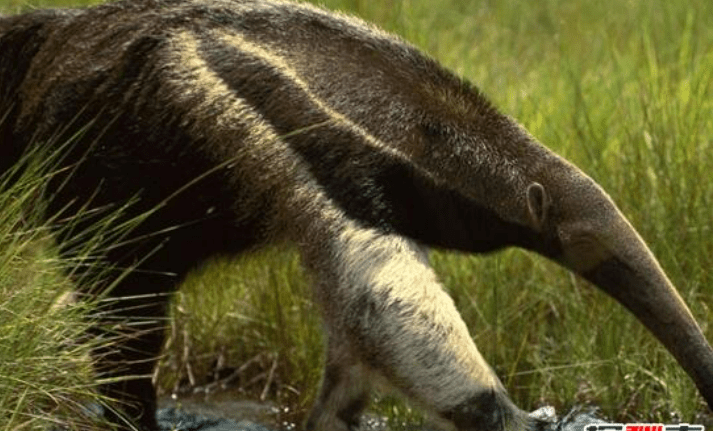The world’s largest anteater, the giant anteater, is a 2.4-meter-long ant hunter (and can kill humans)

In people’s eyes, the animal world is a wonderful yet cruel world, vividly demonstrating the survival of the fittest. The appearance of animals is even more frightening, because they give people the feeling of being ferocious and brutal. However, the giant anteater, despite being as large as a human in size, is a gentle animal.
There are four types of anteaters: the giant anteater, the medium and small anteaters of Central and South America, the small anteater, and the pygmy anteater.
The largest living anteater is up to 2.4 meters long and weighs 65 kilograms.
The giant anteater is a species of anteater found in some parts of the Americas. They mainly inhabit tropical grasslands and forests, and usually live alone in moist areas such as grasslands, leaf litter, and rainforests. It can grow up to 1.8-2.4 meters in length and usually weighs between 29-65 kilograms. The male weighs around 50 kilograms, while the female weighs around 55 kilograms.

Its fur is long and hard, up to 0.4 meters long. Its appearance is unique, with a tail full of fur, a small head, tiny eyes and ears, and a tubular snout. It has no teeth, but a long, flexible tongue. It can eat up to 30,000 ants and other insects in a day, making it a famous ant killer. Its front legs, except for the five fingers, all have hook claws, which are very sharp. Its hind legs are relatively short, but they provide support for its entire body.

The giant anteater has a long mouth. When the nose at the front of its mouth detects the scent of ants, it will use its sharp front claws to dig into the ant nest, reaching the center of the ant nest. When the ants are running around, it will stretch out its 0.3-meter-long tongue, which is covered in sticky saliva, to trap the ants, allowing it to eat many ants at once. It becomes the number one killer of ant armies.

Three other types of animals in the anteater family. The pygmy anteater is the smallest of the anteaters, with a volume of only a few egg weights, only one-fifth of the giant anteater. The lesser anteater is mainly distributed in Central America, with grayish-yellow fur on its limbs and a blackish-brown body. The tamandua has a similar body size and habits to the lesser anteater, with a linen-colored and brown fur covering its entire body.
Giant anteater self-defense killing incidents

Anteaters are generally considered to be gentle animals in people’s impressions, and some people like to keep them as pets. But researchers have overturned this conventional theory and publicly reported two incidents in Brazil in recent years where giant anteaters attacked and killed humans. This report has aroused strong public attention, especially to understand why they, who are gentle in nature, would harm humans.

The first incident occurred in northern Brazil, when a 47-year-old man and his two sons were hunting with a hunting dog. They were suddenly attacked by a giant anteater. The hunter pulled out his knife and approached the anteater, but did not fire. The giant anteater was frightened, backed away, stood up on its hind legs, and vigorously scratched the hunter with its forelimbs, causing severe injuries to his thigh and arm and leading to excessive bleeding and death.

In the second incident, a 75-year-old man was also attacked by a giant anteater while hunting, and he died shortly after the conflict due to excessive bleeding from the femoral artery. However, it is uncertain whether the old man attacked the anteater first in this incident, and the giant anteater may have harmed humans in self-defense. Both victims of the incidents were farmers who were hunting, indicating that under normal circumstances, the giant anteater would not actively attack humans.

Researchers have shown that giant anteaters are actually easily frightened by external factors. For example, passing planes or moving leaves can startle them. In an emergency, they will become more alert, usually standing on their hind legs and using their powerful forelimbs to attack.

Over the past decade, people have been continuously developing resources, destroying the environment, and hunting animals excessively, leading to a decrease of about 30% in the number of anteaters. Therefore, the International Union for Conservation of Nature has listed anteaters as vulnerable animals. Animals are human’s best friends, and here, we remind the general public to protect animals and our home.
